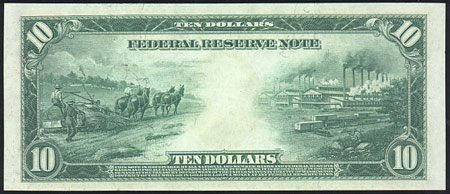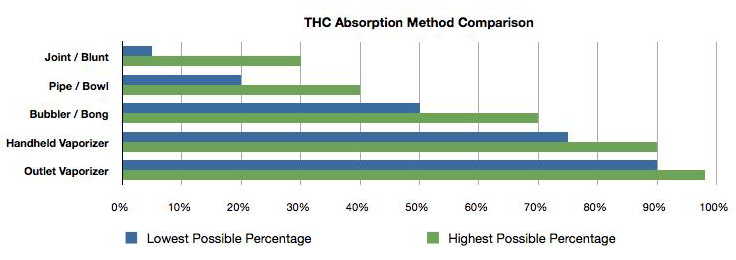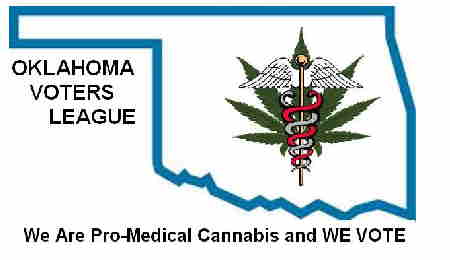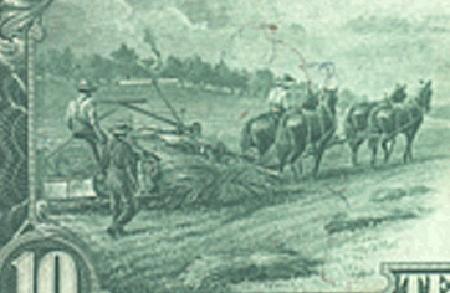
|
 |

|
|---|
OF INDUSTRIAL HEMP
A while back an Oklahoma Voters League member sent a letter to one of our highest ranking Oklahoma (Federal) elected officials requesting her help in the passage of an agricultural Hemp Bill, that was then before Congress. If passed, it would have (once again) allow American Farmers to grow Industrial Hemp if low ‘thc’ grade seed were used.
Normally, the Oklahoma Voters League views itself solely as a pro-Medicinal Cannabis group and as such tends to shy away from other issues; --- Including that of ‘Industrial Hemp.’ And granted, while the subject is very closely related, still we prefer to concentrate our energies solely on helping medical patients (especially cancer victims), who so desperately need Medical Cannabis to be re-legalized. HOWEVER, it has been noted that the ideological reasons that find many in opposition to American farmers cultivating ‘Industrial Hemp,’ are the very same reasons for their opposition to re-legalizing Medical Cannabis.
Thus the reason why we are making this one exception to the rule, especially as the author of this letter (a federally elected official), has also extensively corresponded with us about her opposition to Medical Cannabis.

[Ten dollar bill (era 1910's) and yes that is a Hemp farmer]
August 6, 2013 |
|---|
OF IDEOLOGICAL FACTORS:
Normally at this point we would go right into our own reply, pointing out the technical errors (of which there are usually many), but doing our best to keep our opinions aside. Here however the very issue is ‘ideology’, thus making it (in this case), impossible to do so. Literally speaking, the facts do not matter; -- it is the ideology of prohibition that is important. Need proof, go to the following web-site, which we dub, “None Dare Call it Treason.”
http://reefermadnessmuseum.org/chap04/NewYork/NY_RMTreason.htmNOTE that the incident happened during the middle of the Second World War, making it not an act of stupidity, but an ACT OF out and out TREASON. As we point out:
- The Hemp in question had already been grown and was quite literally just laying around in a farmer’s field. -- Translation, no materials or labor (presumably needed elsewhere for the war effort) would have been used.
- That there was “no interest in the flowering tops,” meaning the only interest in question was Industrial (cloth, paper) in nature.
- That the following wording is used, “ a far greater hazard to have this stock laying around in the fields than putting it into process.” Meaning that even if one believed that Marihuana was “The Weed of Madness.” Logic and reason would dictate that the Industrial Hemp in question would be in much better hands being processed rather than just lying around in some farmers field somewhere.
- That Government owned hemp mills were (at the same time) processing similar hemp stocks. The only difference here being that a private concern would be processing the stock.
As another example:
http://reefermadnessmuseum.org/chap04/Illinois/IL_IHSherwinWilliams.htmDo your really expect me or anyone out there to believe that the Sherwin Williams paint company were a bunch of drug dealers?
[please skim read only]
OKLAHOMA VOTERS LEAGUE REPLIES:
The letter begins with:
August 6, 2013This first part of her reply letter is very candid and also very stunning. It shows that its author has an in-depth knowledge of the subject. And note how there is no kidding around. The fact is that American Farmers are being pounced into the grown by this policy. On the bright side however, the Red Chinese farmers are doing real good by it.
Dear Ms. [name withheld]
“Thank you for your message in support of the Industrial Hemp Farming Act (S. 359) being included in the Farm Bill (S. 954). It is good to hear from you, and I appreciate you taking the time to write. Also, thank you for sharing the links to the Congressional Research Service and THOMAS reports.
Senator McConnell’s amendment to the Farm Bill regarding hemp did not receive a vote during consideration of the bill. As you mention, this amendment mirrored the language of S. 359, which would amend the Controlled Substances Act by stating that marijuana does not include industrial hemp. Industrial hemp is defined as “the plant Cannabis sativa L. and any part of such plant, whether growing or not, with a delta-9 tetrahydrocannabinol [THC] concentration of not more than 0.3 percent on a dry weight basis.”
As you know, there is a difference between the drug marijuana and industrial hemp as a component in a broad range of products. The plants are technically the same species, Cannabis sativa, but have significant genetic differences. Hemp seeds and seed oil are used for foods, supplements, personal-care products, and paint, while hemp stalks are used for fabric, rope, carpeting, and various textiles. In 1970, Congress effectively banned production of hemp, but did not ban the fiber, oil, and other components that cannot be used to grow the plant. As a result, the U.S. currently imports about $10 million worth of hemp products a year. China is the primary supplier of hemp fiber to the United States, and Canada is the primary supplier of hemp seed and oilcake. Approximately 30 countries permit production of hemp.”
Your letter goes on to say:
“Hemp has much lower concentrations of THC, the psychoactive component of marijuana that induces euphoria and harmful symptoms. Proponents of hemp argue drug users would be unable to get “high” by smoking plants with THC concentrations of 0.3 percent or less. Some also contend the higher concentration of cannabidiol (CBD) in hemp counteracts the effects of THC and makes it useless for obtaining a “high.”Ms. . . ., one cannot understate enough that Narcotics Police officials; Simply are not telling it the way it is! Their nefarious agenda, which includes preventing Cancer patients from obtaining proper medical treatment, makes them very suspect. And I for one would be very suspicious of any material presented by them, as they have become very skillful at (via verbal slight of hand) manipulating figures and statistics to their great advantage.
However, in 2001 the Drug Enforcement Administration published a ruling reviewing the scientific literature on the different varieties of Cannabis sativa, including hemp (available here: http://1.usa.gov/S8hNBr). Several studies examined the effects of THC concentration of 1 percent or less, and found the THC still had measurable effects on subjects. One study found that even concentrations of 0.16 percent and 0.3 percent increased participants’ subjective experience of drug-like mental effects, decreased hand-eye coordination, and decreased mental performance on an auditory feedback test. Most participants in the study correctly identified even the lowest dose as active marijuana. As for the presence of cannabidiol (CBD) in hemp, the review found that CBD does block some of the effects of THC, but actually enhances others, including the euphoric “high.”
Example: Referencing the study by Kiplinger GF, Manno JE, et al, “Dose-response analysis of the effects of tetrahydrocannabinol in man” -- Clinical Pharmacology Therapeutics (1971) V12: p650. Which is prominently mentioned in the DEA report being quoted by your office states as follows:
“Marijuana cigarettes were manufactured to deliver doses of 0, 6.25, 12.5, 25, and 50 μ/kg of (delta)9-THC. Based on an average 70 kg man, the total delivered doses of THC were 0, 0.43, 0.875, 1.75, and 3.5 mg. Based on the assumption of a 50% loss of THC from pyrolysis and sidestream smoke these doses would be equivalent to smoking cigarettes containing 0, 0.08%, 0.16%, 0.3%, and 0.7% THC containing hemp.”Is this correct? : I for one do not believe so. --- First they are correct in stating that the administered dozes of 'thc' during the study were 0, 6.25, 12.5, 25, and 50 micro-grams per kilo-gram of body weight. [see table below, column 1] Which translates (assuming a 70 kilo-gram human) into the values as given in column 2 (given here in mili-grams of 'thc').
| Given μ grams per kilogram of bodyweight | 'thc' administered (milligrams) per 70 kilogram male | % thc administered | 'thc' % within cigarette | (Column 4) X6 adjusted |
| 0 | 0.00mg | 0% | 0% | 0% |
| 6.25 | 0.44mg | 0.0875% | 0.175% | 1% |
| 12.5 | 0.88mg | 0.175% | 0.35% | 2% |
| 25 | 1.75mg | 0.35% | 0.7% | 4% |
| 50 | 3.50mg | 0.7% | 1.4% | 8% |
So far no problems, however they then go on to claim that these figures translate into the percentages of ‘thc’ content (as shown by column 4) of the hemp cigarette itself. This I feel is in error. The report by Kiplinger and Manno, clearly states that there was a 50% loss factor between the ‘thc’ contents of prepared Hemp cigarette and that which was actually administered to the test subjects. In another study by the same authors; “Comparative effects of smoking marihuana or placebo on human motor and mental performance” (Clinical Pharmacology Therapeutics (1970) Vol 11: 811) the following is quoted:
“We therefore feel that it is reasonable to assume that a dose of approximately 5 mg of (thc) was delivered; and administered dose (would be) in the range of 50 to 75 micrograms per kilograms (of body weight)” [NOTE if you do the math, 50 to 75 micrograms administered comes out to 5mg per cigarette minus the 50% loss]Thus making it quite clear that their studies were factoring in the difference between the percentage of ‘thc’ content of the hemp cigarette and that which was being physically administered to the test subjects; --- which they measured as being 50%. --- THUS the true percentages of ‘thc’ content are actually reflected by column 4 NOT column 3 of the table.
And then there is the method of administrative delivery that also worries a lot of us. While I/we have not been able to fully verify the exact accuracy of the graph below, still statistically it appears about right.

Note that the Kiplinger, Manno study being quoted made use of a 'Supper Hyped Up' electronic vaporizer or the most effective method of administrative delivery possible. Literally it is about 6 times more effective than a cigarette could ever be, which explains the comparative percentages shown on column 5. Assuming that one were actually smoking a cigarette, those would be the equivalent percentages of 'thc' content that one would need to achieve the same results as the study came up with.
Granted, there is nothing to keep a Hemp smoker (who doesn’t want to buy beer) from smoking Industrial Hemp grade via an electronic vaporizer BUT still . . . . Column 5 does indicate that the study (which made use of such an unrealistic delivery system) did NOT measure the use of industrial Hemp grade stuff, not at all. However in any case, the point being made is that I wouldn’t trust anything the D.E.A. comes out with and nether should you.
Your letter continues:
The research I have reviewed on hemp does not conclusively establish the plant is likely to be seriously abused. The scientific literature raises enough concerns, however, that I would not be in favor of legalizing hemp at this time.Ms. . . ., it is hard to gage exactly what you meant by, “SERIOUSLY ABUSED.” Simply put, Marihuana is safer than beer and if anyone needs any proof; -- please provide me with just one name of anyone who has ever died from its use. You will be very hard pressed to find even one such case. However, here the issue seems to be ideology;--- in the words of Robert Heinlein:
“Must be a yearning deep in (the) human heart to stop other people from doing as they please. Rules, laws - always for (the) other fellow. A murky part of us, something we had before we came down out of trees, and failed to shuck when we stood up.”So let’s just do a bit of math. The average Medical patient (for whom Cannabis is appropriate) requires around four (1 gram ) cigarettes per day. For the sake of argument let's presume each cannabis cigarette has a 4.5% ‘thc’ concentration. [A]
As Industrial Hemp is suppose to have only a ‘thc concentration of 0.3 or less the math works out to:
(4.5%) / (0.3%) =~ 15
Meaning that the average medical patient will require NOT FOUR, BUT SIXTY cigarettes per day. AND to add insult to injury, in order to get the medical effect, -- that patient will be required to smoke at least 7 or 8 of them ALL AT ONE TIME. And this assumes that the Industrial Hemp in use has the higher limit of 0.3%.
SO GRANTED, it is possible, but highly unlikely that anyone (including the most desperate of desperate of unwashed hippies) will every really make use of it.
Your letter continues:
“My concerns are increased by the fact that some of the most vocal proponents of legalizing hemp are also proponents of legalizing marijuana. This leads me to question the intentions of some of those who wish to grow hemp. In light of these concerns, better research is needed before Congress should consider lifting the prohibition on the plant.”Ideologically speaking (placing ourselves in your shoes), one can see how you might have come to this conclusion. However, technically speaking it is not exactly true. For many years (until very recently), there were many (mostly environmental types) who were strong supporters of Industrial Hemp, yet equally strongly opposed legal Marihuana and some even to its Medicinal uses.
However, in recent years all that has changed as many of these same individuals have now come to the conclusion that there will never be re-legalized Industrial Hemp WITHOUT the end of the anti-Medical Cannabis laws as well.
And as an aside, it is interesting to note that the opposite side of the coin can be used here. ---- It appears that the most vocal opponents of legalizing Industrial Hemp are also opponents of legalizing Medicinal Cannabis. This leads me to question the true intentions of some of those who wish to stop its growth by American farmers. And as for more research, how much more research does one need before it becomes obvious to everyone that to opponents, this is just another excuse to delay, delay, delay, and NOT do the right thing.
If we may point out just “some” of the countries that are now allowing their farmers to grow Industrial hemp:
- AUSTRALIA
- CANADA
- GREAT BRITAIN
- AUSTRIA
- FRANCE
- FINLAND
- JAPAN
- SPAIN
- SWITZERLAND
Your letter ends with:
I am certainly sensitive to your desire to see hemp grown in the United States for legitimate industrial purposes. However, I believe the risk related to illicit production of marijuana outweighs the potential benefits from hemp farming. Therefore, I will support the importation of legal hemp substances, while opposing the cultivation of hemp domestically due to the risk of disguising marijuana production as hemp production.Without comment.
Thank you again for writing. Best wishes.
Sincerely,
[name contact info withheld]
CLOSING THOUGHTS:
“Are there any examples anywhere of abuse of industrial hemp?” -- Question asked by an Oklahoma Voter League memberFirst for those out there that really don’t know:
- YES, George Washington (our first president) did grow Hemp.
- YES, So did Thomas Jefferson and in fact he was a smuggler.
- YES, so did a lot of our earliest Presidents.
http://reefermadnessmuseum.org/chap04/Virginia/VA_IndHempP1.htmHowever, that is nether here nor there, what is important is our present day situation, which can be traced back to the Reefer Madness campaign of the 1930’s. And for those of you who have never heard of it; - simply put those in whom the American people trusted betrayed that trust by lying to us. They began fabricating stories that something (not identified by name but instead) called, “MARIHUANA the killer Drug,” was going to make you go out and kill your parents or jump out of a fifth story window, etc. That numerous “COLD BLOODED BESTIAL ACTS” had been traced to its use, etc. . . . . And in case you think that we are making all of that up, just look at what happened right here in Oklahoma; --- WE repeat, here in Oklahoma.
http://reefermadnessmuseum.org/chap04/Oklahoma/RMOklahoma.htmAnd thus it was this hysteria campaign of lies which allowed for the passage of the original anti-Cannabis laws, which in one form or another are still with us to this very day. In fact the laws that we have now are probably a lot sicker than the ones we originally had back then (in the 1930’s). Today, not only are farmers now allowed to grow Industrial Hemp (a much, much weaker cousin of Marihuana), but medical patients (including even those with cancer) are not allowed its legal use.
[note, this site documents Harry Anslinger’s Gore file for the State of Oklahoma]
In closing we will end where we began, by stating that the Oklahoma Voters League is a pro-Medical Cannabis group and as such we really don’t do all that much on the issue of Industrial Hemp. However, it seems obvious that those who oppose Industrial Hemp are also “for ideological reasons” the very same individuals who oppose re-legalizing the use of Medical Cannabis. And all we can do for them is pray that they learn what Jesus once said, --- Know the Truth for the Truth shall set you free.
==============
FOOTNOTES:
[A]- Most of my research is antidotal. Answers given back by Medical patients who I find reliable. Questions asked to Medical Cannabis club owners. Note that we are referencing a cigarette similar in size/weight to a standard tobacco cigarette; -- having an average content of about 4 to 4.5% thc content.

|
-- BACK -- MORE REPLY LETTERS |
WANT TO KNOW MORE:
=====================
Due to space / download time considerations, only selected materials are displayed. If you would like to obtain more information, feel free to contact the museum. All our material is available (at cost) on CD-Rom format.
CONTACT PAGE
(A Pro Medical cannabis Organization)
ADD YOURSELF TO OUR MAILING LIST:
http://drugsense.org/lists/listform.htm?okvotersleague
BACK TO  OKLAHOMA MAIN PAGE |

|
Our Motto - We're pro-Medical Cannabis and we Vote!
